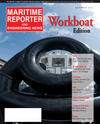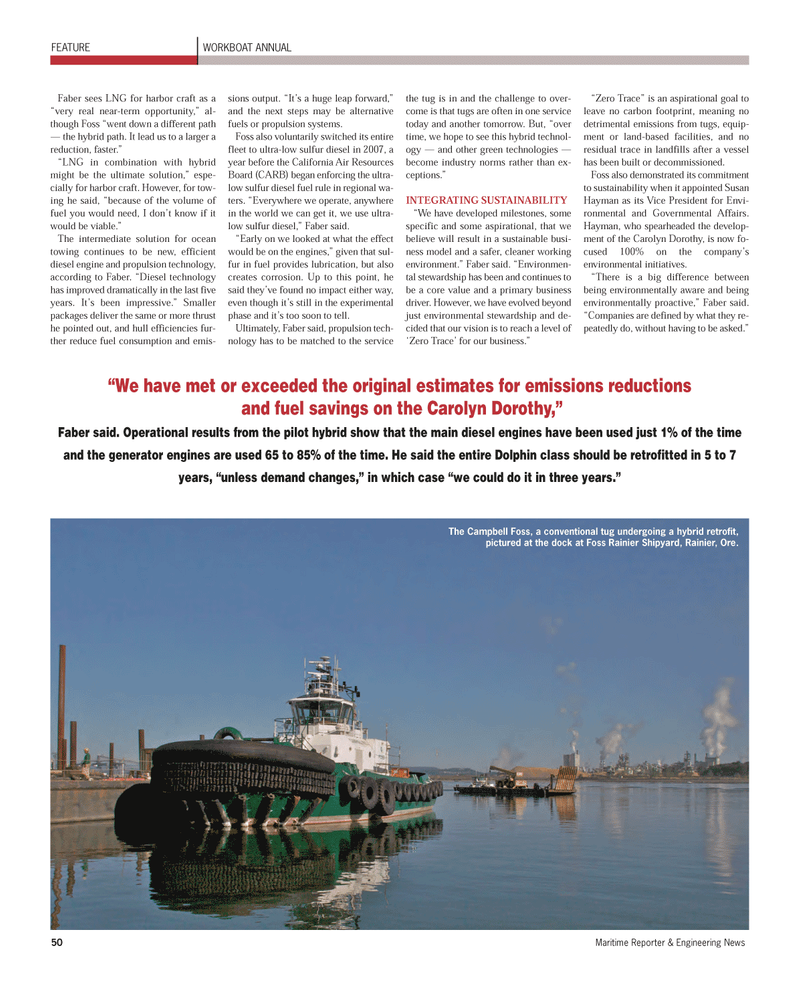
Page 50: of Maritime Reporter Magazine (November 2011)
Feature: Workboat Annual
Read this page in Pdf, Flash or Html5 edition of November 2011 Maritime Reporter Magazine
Faber sees LNG for harbor craft as a ?very real near-term opportunity,? al- though Foss ?went down a different path ? the hybrid path. It lead us to a larger a reduction, faster.? ?LNG in combination with hybrid might be the ultimate solution,? espe- cially for harbor craft. However, for tow- ing he said, ?because of the volume of fuel you would need, I don?t know if it would be viable.? The intermediate solution for oceantowing continues to be new, efficient diesel engine and propulsion technology, according to Faber. ?Diesel technology has improved dramatically in the last five years. It?s been impressive.? Smaller packages deliver the same or more thrust he pointed out, and hull efficiencies fur- ther reduce fuel consumption and emis-sions output. ?It?s a huge leap forward,? and the next steps may be alternative fuels or propulsion systems. Foss also voluntarily switched its entire fleet to ultra-low sulfur diesel in 2007, a year before the California Air Resources Board (CARB) began enforcing the ultra- low sulfur diesel fuel rule in regional wa- ters. ?Everywhere we operate, anywhere in the world we can get it, we use ultra- low sulfur diesel,? Faber said. ?Early on we looked at what the effect would be on the engines,? given that sul- fur in fuel provides lubrication, but also creates corrosion. Up to this point, hesaid they?ve found no impact either way, even though it?s still in the experimental phase and it?s too soon to tell. Ultimately, Faber said, propulsion tech- nology has to be matched to the servicethe tug is in and the challenge to over- come is that tugs are often in one servicetoday and another tomorrow. But, ?over time, we hope to see this hybrid technol- ogy ? and other green technologies ?become industry norms rather than ex- ceptions.? INTEGRATING SUSTAINABILITY ?We have developed milestones, some specific and some aspirational, that webelieve will result in a sustainable busi- ness model and a safer, cleaner working environment.? Faber said. ?Environmen- tal stewardship has been and continues to be a core value and a primary business driver. However, we have evolved beyond just environmental stewardship and de- cided that our vision is to reach a level of ?Zero Trace? for our business.? ?Zero Trace? is an aspirational goal to leave no carbon footprint, meaning no detrimental emissions from tugs, equip-ment or land-based facilities, and no residual trace in landfills after a vessel has been built or decommissioned. Foss also demonstrated its commitment to sustainability when it appointed SusanHayman as its Vice President for Envi- ronmental and Governmental Affairs. Hayman, who spearheaded the develop- ment of the Carolyn Dorothy, is now fo- cused 100% on the company?s environmental initiatives. ?There is a big difference between being environmentally aware and being environmentally proactive,? Faber said. ?Companies are defined by what they re- peatedly do, without having to be asked.? 50Maritime Reporter & Engineering News FEATURE WORKBOAT ANNUAL ?We have met or exceeded the original estimates for emissions reductions and fuel savings on the Carolyn Dorothy,? Faber said. Operational results from the pilot hybrid show that the main diesel engines have been used just 1% of the time and the generator engines are used 65 to 85% of the time. He said the entire Dolphin class should be retrofitted in 5 to 7 years, ?unless demand changes,? in which case ?we could do it in three years.? The Campbell Foss, a conventional tug undergoing a hybrid retrofit, pictured at the dock at Foss Rainier Shipyard, Rainier, Ore. MR Nov.11 # 7 (50-56):MR Template 10/28/2011 11:37 AM Page 50

 49
49

 51
51
